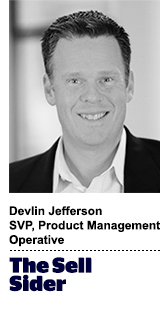 “The Sell Sider” is a column written for the sell side of the digital media community.
“The Sell Sider” is a column written for the sell side of the digital media community.
Today’s column is written by Devlin Jefferson, vice president of product at Operative.
Bauer Xcel recently gave publishers advice about working directly with brands that take programmatic in-house. Note that the advice was written by Bauer’s new in-house programmatic sales director, who’s focused on programmatic guaranteed and other premium programmatic formats.
Advertisers and publishers are finally focusing on premium programmatic channels to move closer together, hiring new positions inside their organizations and adding value for both parties.
Bauer is not alone in hiring sellers that specialize in programmatic guaranteed and direct programmatic offerings. EMarketer predicts that nearly 80% of programmatic media will be transacted through private marketplaces and direct deals by 2020. That requires personal human expertise as much as it adds automation to the direct sales process.
Demand-side platforms and supply-side platforms have their place, but publishers gain a lot when they take programmatic guaranteed into their own hands.
Long-tail flight
Some advertisers are eager to leave long-tail media for premium publishers and big platforms. Of course, some of that money will go to Google and Facebook, but premium publishers can lock up lucrative deals with advertisers looking for safe placement and would do well to focus on this rapidly expanding channel. In exchange for safety, many advertisers are willing to pay in advance to secure good inventory and will be pleased with the results.
Programmatic guaranteed is the opposite of open exchange bidding on the long tail, which means it fits better with typical premium publisher models. Not only are advertisers securing ad inventory on known publisher sites, they can dictate a lot about pricing, placement and audience. This gives publishers a chance to forge deeper relationships and learn more about what advertisers want, shaping their products to fit new demand.
For example, many long-tail exchange campaigns are based on audience targeting using opaque third-party data. As publishers learn more about what advertisers are actually trying to target, they can suggest swapping out third-party data segments for more reliable and accurate publisher data for a win-win.
Smooth out the yield curve
AdExchanger Daily
Get our editors’ roundup delivered to your inbox every weekday.
Daily Roundup
Many publishers have been dealing with a black-and-white divide between direct and programmatic sales until recently. With the dramatic increase in programmatic guaranteed and other premium programmatic products, the gray area in between becomes the focus. Yet most publisher teams haven’t organized around a unified yield curve concept that plots the relative profitability across all hybrid direct and programmatic offerings. Worse, publishers rarely create top-down strategies that put automated products first.
Programmatic guaranteed should be the catalyst to unify revenue decision-making into a streamlined picture. There is no reason why any premium content site should be earning more on direct channels than on programmatic for the same placement, but particularly not through programmatic guaranteed, which provides the best of both worlds.
An easier way to achieve quality at scale
Advertisers have been trained to expect targeted, high-quality inventory at scale on automated platforms like Facebook and Google, and they are more than ready to hear a pitch from their premium content partners. Many publishers are still cobbling together the wrong offering to compete, focusing on anonymous extension networks and building scale purchased from Facebook and Google.
Premium automated products set the stage for digital publishers to offer quality and scale, but they must work more closely together, aligning like-minded companies and equally valuable content to preserve prices and avoid wrong-headed scale-building tactics. TV companies have started to come together around cooperatives such as OpenAP in anticipation of targeted advanced TV, yet digital publishers, which have had years to digest programmatic advertising, rarely show the same willingness to cooperate. This should change.
Programmatic guaranteed is not a panacea. It requires a lot of work to manage effectively, but I believe that it’s the future of premium ad sales. It’s therefore an important channel that publishers need to knit into the fabric of their sales and operations to pave the way for future growth. It would be even better if publishers worked together to do it right.
Follow Operative (@Operative_Media) and AdExchanger (@adexchanger) on Twitter.












